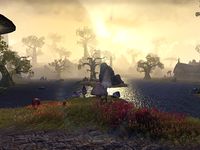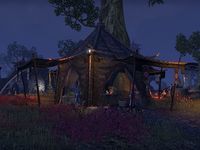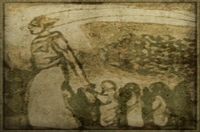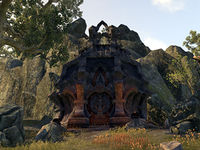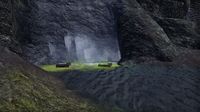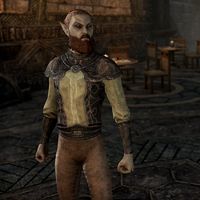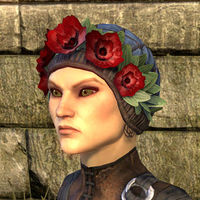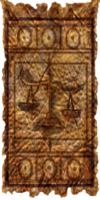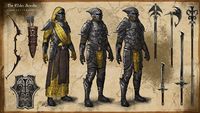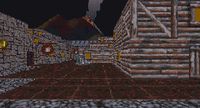Lore:Narsis
| Narsis | |
|---|---|
| Type | Settlement |
| Continent | Tamriel |
| Province | Morrowind |
| Region | Deshaan (Redolent Loam) |
| Appears in | Arena, ESO |
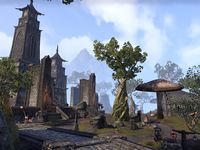
|
Narsis is one of the eight major cities on the mainland of Morrowind,[1] and is built on the southern shores of Lake Hlaalu. The city is historically known as the ancient capital of the former Great House Hlaalu, whose sphere of influence revolved around mercantilism and adaptation. They once reigned over west-central Morrowind.[2][3] When it was originally founded in the Merethic Era, it was known as Narsis-Where-All-Fervently-Praise-the-Prophet-Veloth until it was shortened to its current name.[4]
Layout and Geography[edit]
As the capital of House Hlaalu, Narsis was the center of a district that spanned across central Morrowind.[3] By the Third Era, it encompassed everything from Balmora and Suran to the northeast in Vvardenfell,[5][6] Ebonheart on the Inner Sea's southern coast,[7][UOL 1] and Kragenmoor in the Valus Mountains to the north.[UOL 1]
The city itself is located in the Deshaan region, specifically the Redolent Loam river basin centered around Lake Hlaalu, where it can be found on its south shore[8] and east of the Velothi Mountains.[9] Narsis is neighbored by several settlements, including Heimlyn Keep to the northwest, Old Keep to the northeast, and Black Marsh to the south,[1] toward Stormhold.[10]
Narsis is one of Morrowind's smaller cities. It is built on a hillock that overlooks the lakefront to the north, and at the top of it lies the local kinhouse. However, the hill has a stone foundation built around it, providing ample space around it and elevation above the rest of the settlement. The city is surrounded by low-barring walls and much of the landscape is uneven ground; as a countermeasure, these hills are surrounded by stone platforms like under the kinhouse. The center of town is quaint parkland with tall stalks of Emperor Parasols,[8] sprawled out chanterelle mushrooms, vibrant red barberry bushes, and large sharp rocks.[9] The west side of the city contains the local marketplace consisting of trader tents. In the town outskirts, a lone watchtower can be found to the south and to the west lies the ruins of ancient Narsis,[8] which expands underneath the modern city and includes the foundation of the original settlement.[4]
Notable Locales[edit]
|
|
Districts[edit]
|
History[edit]
Early History[edit]
The settlement was originally founded by the Prophet, Veloth[9] and his Chimer followers during the great exodus in the late-middle Merethic Era.[4][14] The town was known as Narsis-Where-All-Fervently-Praise-the-Prophet-Veloth, but over time, its name was shortened.[4] House Hlaalu is one of the original Great Houses of Morrowind,[3] which date their origins to the late Merethic Era during the decline of High Velothi Culture.[15] How they came to be associated with Narsis is unknown but House Hlaalu presided over the city since at least the 121st Year of the Golden Peace.[3]
The house later partook in the War of the First Council, a conflict in the seventh century of the First Era.[16] Chimer forces were stationed in Narsis before they joined the Dwemer at the Battle of Red Mountain. At around the same time, an army of Nords led by King Wulfharth were also approaching the battle.[17]
For the longest time, House Hlaalu and House Dres coveted territory south of Narsis that borders their respective districts. It was until 2E 559 that their usual confrontations evolved into full-scale war in the form of the War of Two Houses. After a small contingent of Hlaalu guards led by Purilla Falen was able to survive the first wave of Dres mercenaries, a portal mage attempted to summon one to Narsis for reinforcements. Despite the imposing numbers, Falen and the Hlaalu guards did not falter even when three of them were left. When the portal was finally opened, Hlaalu battle-merchants flooded the scene and ultimately secured the trading post. And although Purilla Falen died in battle, her efforts were never forgotten.[18]
Narsis and the Llodos Plague[edit]
During the Interregnum in 2E 582, the Llodos Plague was spreading all throughout Deshaan and was en route to Narsis after an outbreak in Serkamora. It was initially developed by the alchemist, Merdyndril, though one member of the Maulborn Cult managed to create a more potent strain of the disease, which was later dumped into the city's water supply and Lake Hlaalu.[19]
Panic and paranoia swept through Narsis as several people disappeared in the middle of the night. Councilor Ralden was having trouble deciding on a proper course of action. His advisor, Giron Sadri offered an investigation and suggested quarantining the city from the outside, even if it harmed Narsis' economy. The Councilor enlisted the help of an Agent from the Ebonheart Pact to undergo their own investigation, which eventually involved the Morag Tong.[20]
Their search brought them to the Maulborn camps on Lake Hlaalu, where the Tong agent, Naryu Virian revealed Sadri's true intentions and his involvement with the Maulborn.[21] At some point, the remaining citizens attempted to rally and search for the missing people, but it is unknown whether that amounted to anything. The agent defeated Councilor Sadri in the city ruins and was able to rescue the captured villagers along with Councilor Ralden. The situation in Narsis had subsided and the Agent led further assistance in the raid at the Obsidian Gorge.[22]
Narsis and the Third Empire[edit]
Back when Tiber Septim first directed the Imperial Army to conquer Morrowind, the Great House Hlaalu was the first to seek accommodations for the westerners and support for the Armistice. Since then, House Hlaalu had grown exponentially over the other great houses.[23] The Imperial Proconsul was established in Narsis and although they governed in an official capacity, some believe they were out of touch with what really happened across Morrowind.[11] In 3E 80, Galana Septim, daughter of Emperor Uriel II was arranged to marry the Duke of Narsis, even though she was promised to the King of Solitude, Mantiarco. Her thirteen-year-old niece, Potema went in her stead.[24]
During the Imperial Simulacrum in the late Third Era, the city-state of Narsis was an active settlement. It was ruled by Queen Vermothah and had a rivalry with Mournhold.[25] House Hlaalu was stripped of its position as a Great House and removed from the Grand Council of Morrowind early in the Fourth Era,[26][27] with its position filled by House Sadras.[28] It is unknown what happened to their capital of Narsis as a result.
Known Rulers[edit]
- The Second Era
- The Third Era
Culture and Society[edit]
Narsis is the capital of House Hlaalu, although unlike other cities affiliated with them, it is not built in its unique architectural style. Instead, the modern city is made in a style prevalent across central mainland Morrowind, with the most notable example of this being Mournhold.[8] The city's founder, Veloth is also House Hlaalu's patron saint.[30] The city is known for its vibrant crimson peonies, which are made into vivid wreaths and fashioned into garden hats.[31] Lake Hlaalu is Narsis' water source.[32]
The Green Narsis Guar is the standard mount and dray-beast in central Morrowind[33] and bantam guar hash is a dish native to Narsis.[34] Brewers from the city also make a signature wickwheat ale, which is also made from yerba mate and isinglass.[35] In Narsis and nearby Almalexia, the flying insects used by House Telvanni are priced incredibly high.[2] The local guards of the city are known as the Narsis Protectors.[36][37]
Gallery[edit]
Notes[edit]
- Arena was originally conceived as a fighting game featuring a tournament that took the player to each of Tamriel's cities to challenge different gladiatorial teams. According to a file from that stage of development left behind in the final game, Narsis' gladiatorial team would have been called "the Stormlords".[UOL 3]
- The Storm Lords are one three factions employed in the gladiatorial guild called the Circle of Champions. They were active all throughout Tamriel in the Second Era, in various major cities and landmarks across the provinces.[38]
See Also[edit]
- For game-specific information, see the Arena and Elder Scrolls Online articles.
References[edit]
- ^ a b Map of Morrowind – The Elder Scrolls: Arena
- ^ a b Pocket Guide to the Empire, 1st Edition: Morrowind — Imperial Geographical Society, 2E 864
- ^ a b c d Understanding House Hlaalu — Hlaandu Hlaalu, Grand Historian for the House
- ^ a b c d Narsis Ruins loading screen text in ESO
- ^ Guide to Vvardenfell
- ^ Suran in Morrowind
- ^ The Real Barenziah, v 5 — Anonymous
- ^ a b c d Narsis in ESO
- ^ a b c Velothi Reverie in ESO
- ^ Map of Black Marsh – The Elder Scrolls: Arena
- ^ a b c d People of Morrowind — Various
- ^ West Narsis Wayshrine in ESO
- ^ Operations Report: West Narsis Mining Concern — Alven Nadus, Overseer
- ^ Veloth the Pilgrim — Cascius the Proud
- ^ Before the Ages of Man — Aicantar of Shimerene
- ^ The War of the First Council — Agrippa Fundilius
- ^ Five Songs of King Wulfharth
- ^ War of Two Houses — Drelisa Hlaalu, House Historian
- ^ The Llodos Plague — Alchemist Merdyndril
- ^ For Their Own Protection story quest in ESO
- ^ Unwanted Guests story quest in ESO
- ^ Hiding in Plain Sight story quest in ESO
- ^ On Morrowind — Erramanwe of Sunhold
- ^ a b The Wolf Queen, v1 — Waughin Jarth
- ^ a b Narsis location and rumors in Arena
- ^ History of Raven Rock, Vol. III — Lyrin Telleno
- ^ Adril Arano's dialogue in Skyrim: Dragonborn
- ^ Lleril Morvayn's dialogue in Skyrim: Dragonborn
- ^ Councilor Ralden in ESO
- ^ Mottos of the Dunmeri Great Houses — Vilyn Girith
- ^ Crimson Garden Flower Hat collectible description in ESO
- ^ Reminder: Don't Drink the Water
- ^ Green Narsis Guar mount description in ESO
- ^ Narsis Bantam Guar Hash in ESO
- ^ Narsis Wickwheat Ale in ESO
- ^ Narsis Protector in ESO
- ^ Letter to Evis Marys
- ^ Battlegrounds PvP mode in ESO
Note: The following references are considered to be unofficial sources. They are included to round off this article and may not be authoritative or conclusive.

